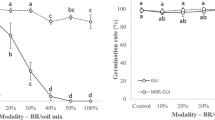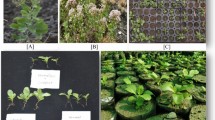Abstract
Bauxite residues from the extraction of alumina from bauxite ore are stored in residue disposal areas. These areas require revegetation and the major constraints and suitable plant species will differ with each site. Germination bioassays were used on bauxite residue from the Aughinish Alumina Ltd. refinery to determine properties inhibitory to seed germination and seedling development. Unamended residue was characterised as having high pH, sodicity, salinity and Al content. These properties had negative tests on seed germination and performance. Amendment of the residue improved chemical properties and greatly increased seedling performance in four test species. Decreased sodicity content in the residue extract resulted in seedling growth greater than achieved in the control. Lolium perenne and Trifolium pratense were identified as useful species for revegetation of amended bauxite residue.



Similar content being viewed by others
References
Al-Harbi, A. R. (1995). Growth and nutrient composition of tomato and cucumber as affected by sodium chloride salinity and supplemental calcium. Journal of Plant Nutrition, 18, 1403–1416.
Bernstein, L. (1974). Crop growth and salinity. In J. van Schilfgaarde (Ed.), Drainage for agriculture (pp. 9–54). Madison: American Society of Agronomy.
Bradshaw, A. D., & Johnson, M. (1992). Revegetation of metalliferous mine waste: The range of practical techniques used in Western Europe. Manchester: Elsevier.
Bucher, M. A. (1985). The effects of gypsum and sewage sludge on plant growth and nutrition on alkaline, saline, fine-textured bauxite residue, M.Sc Thesis, Dept. of Forestry and Environmental Studies, Duke University, Durham.
Catalan, L., Balzarini, Z., Talesnik, E., Sereno, R., & Karlin, U. (1994). Effects of salinity on germination and seedling growth of Prosopis flexuosa. Forest Ecology and Management, 63, 347–357. doi:10.1016/0378-1127(94)90116-3.
Courtney, R. G., & Timpson, J. P. (2005). Reclamation of fine fraction bauxite processing residue (Red Mud) amended with coarse fraction residue and gypsum. Water, Air, and Soil Pollution, 164, 91–102. doi:10.1007/s11270-005-2251-0.
Courtney, R., Mullen, G., & Harrington, T. (2008). An evaluation of revegetation success on bauxite residue, Restoration Ecology (in press). doi:10.1111/j.1526-100X.2008.00375.x.
Fortin, J., & Karam, A. (1998). Effect of a commercial peat moss-shrimp wastes compost on pucinellia growth in red mud. International Journal of Mining. Reclamation and Environment, 12, 105–109. doi:10.1080/09208118908944032.
Fuller, R., Nelson, E., & Richardson, C. (1982). Reclamation of red mud (bauxite residues) using alkaline-tolerant grasses with organic amendments. Journal of Environmental Quality, 11, 533–539.
Hamdy, M. K., & Williams, F. S. (2001). Bacterial amelioration of bauxite residue waste of industrial alumina plants. Journal of Industrial Microbiology & Biotechnology, 27, 228–233. doi:10.1038/sj.jim.7000181.
Ho, G. E., Newman, P. W. G., Mathew, K., & Potter, H. (1985). Neutralization of bauxite processing residue with copperas. Chemeca, 103–108.
Ippolito, J. A., Redente, E. F., & Barbarick, K. A. (2005). Amendment effects on pH and salt content of bauxite residue. Soil Science, 170, 832–841. doi:10.1097/01.ss.0000190510.56545.8d.
Kent, L. M., & Lauchli, A. (1985). Germination and seedling growth of cotton: Salinity-calcium interactions. Plant, Cell & Environment, 8, 155–159. doi:10.1111/j.1365-3040.1985.tb01223.x.
Kinraide, T. B. (1999). Interaction among Ca2+, Na+, and K+ in salinity toxicity: Quantitative resolution of multiple toxic and ameliorative effects. Journal of Experimental Botany, 50, 1495–1505. doi:10.1093/jexbot/50.338.1495.
Lau, S. S., & Wong, J. W. C. (2001). Toxicity evaluation of weathered coal fly ash-amended manure compost. Water, Air, and Soil Pollution, 128, 243–254. doi:10.1023/A:1010332618627.
Marchiol, L., Mondini, C., Leita, L., & Zerbi, G. (1999). Effects of municipal waste leachate on seed germination in soil compost mixtures. Restoration Ecology, 7, 155–161. doi:10.1046/j.1526-100X.1999.72007.x.
Meecham, J., & Bell, L. (1977). Revegetation of alumina refinery wastes. 1. Properties and amelioration of the materials. Australian Journal of Experimental Agriculture, 17, 679–688. doi:10.1071/EA9770679.
Menzies, N. W., Fulton, I. M., & Morrel, W. J. (2004). Seawater neutralization of alkaline bauxite residue and implications for revegetation. Journal of Environmental Quality, 33, 1877–1884.
Munshower, F. F. (1994). Disturbed land revegetation. Florida: Lewis.
Płaza, G., Nałęcz-Jaweckib, G., Ulfiga, K., & Brigmonc, R. (2005). The application of bioassays as indicators of petroleum-contaminated soil remediation. Chemosphere, 59, 289–296. doi:10.1016/j.chemosphere.2004.11.049.
Qadir, M., & Schubert, S. (2002). Degradation processes and nutrient constraints in sodic soils. Land Degradation & Development, 13, 275–294. doi:10.1002/ldr.504.
Rehman, S., Harris, P. J. C., Bourne, W. F., & Wilkin, J. (1996). The effect of sodium chloride on germination and the potassium and calcium content of Acacia seeds. Seed Science and Technology, 25, 45–57.
Rhoades, J. D., & Miyamoto, S. (1990). Testing soils for salinity and sodicity. In R. L. Westerman (Ed.), Soil testing and plant analysis (pp. 299–336). Madison: American Society of Agronomy and Soil Science Society of America.
Shu, W. S., Ye, Z. H., Zhang, Z. Q., Lan, C. Y., & Wong, M. H. (2005). Natural colonization of plants on five lead/zinc mine tailings in Southern China. Restoration Ecology, 13, 49–60. doi:10.1111/j.1526-100X.2005.00007.x.
Solymar, K., & Bujdoso, E. (1973). Properties of red mud in the bayer process and its utilization. TMS Paper No. A73–56. The Metallurgical Society of AIME, 345 E. 47th St., New York, N.Y. 10017.
SPSS (2002). SPSS for Windows (Version 11). Chicago, IL.
The Aluminium Association (2000). The aluminum association. Technology roadmap for bauxite residue treatment and utilization p. 22. Washington: The Aluminum Association.
Tiquia, S. M., Tam, N. F. Y., & Hodgkiss, I. J. (1996). Effects of composting on phytotoxicity of spent pig-manure sawdust litter. Environmental Pollution, 93, 249–256. doi:10.1016/S0269-7491(96)00052-8.
USEPA (1992). Seed germination/ root elongation toxicity test. Washington: EG-12, Office of Toxic Substances, U. S. Environmental Protection Agency.
Waisel, Y. (1972). Biology of halophytes. New York: Academic.
Wang, W., & Keturi, P. H. (1990). Comparative seed germination tests using ten plant species for toxicity assessment of a metal engraving effluent sample. Water, Air, and Soil Pollution, 52, 369–376. doi:10.1007/BF00229444.
Wehr, J. B., Fulton, I., & Menzies, N. W. (2006). Revegetation strategies for Bauxite refinery residue: A case study of Alcan Gove in Northern Territory, Australia. Environmental Management, 37, 297–306. doi:10.1007/s00267-004-0385-2.
Wong, M. H. (2003). Ecological restoration of mine degraded soils with emphasis on metal contaminated soils. Chemosphere, 50, 775–780. DOI 10.1016/S0045-6535(02)00232-1.
Wong, M. H., & Bradshaw, A. D. (1982). A comparison of the toxicity of heavy metals using root elongation of ryegrass Lolium perenne. The New Phytologist, 91, 255–261. doi:10.1111/j.1469-8137.1982.tb03310.x.
Wong, J. W. C., & Ho, G. E. (1993). Use of waste gypsum in the revegetation on red mud deposits: A greenhouse study. Waste Management & Research, 11, 249–256.
Wong, J. W. C., & Ho, G. E. (1994). Effectiveness of acidic industrial wastes for reclaiming fine bauxite refining residue (red mud). Soil Science, 158, 115–123. doi:10.1097/00010694-199408000-00005.
Yang, Z. Y., Yuan, J. G., Xin, G. R., & Chang, H. T. (1997). Germination, growth, and nodulation of Sesbania rostrata grown in Pb/Zn mine tailings. Environmental Management, 21, 617–622. doi:10.1007/s002679900054.
Ye, Z. H., Shu, W. S., Zhang, Z. Q., Lan, C. Y., & Wong, M. H. (2002). Evaluation of major constraints to revegetation of lead/zinc mine tailings using bioassay techniques. Chemosphere, 47, 1103–1111. doi:10.1016/S0045-6535(02)00054-1.
Zucconi, F., Pera, A., & Forte, M. (1981). Evaluating toxicity of immature compost. BioCycle, 22, 54–57.
Acknowledgements
The author would like to thank Aughinish Alumina Ltd. for their financial support for this research. Thanks are also extended to Dr. John Breen of University of Limerick for his assistance with Graphpad Prism.
Author information
Authors and Affiliations
Corresponding author
Rights and permissions
About this article
Cite this article
Courtney, R., Mullen, G. Use of Germination and Seedling Performance Bioassays for Assessing Revegetation Strategies on Bauxite Residue. Water Air Soil Pollut 197, 15–22 (2009). https://doi.org/10.1007/s11270-008-9787-8
Received:
Accepted:
Published:
Issue Date:
DOI: https://doi.org/10.1007/s11270-008-9787-8




